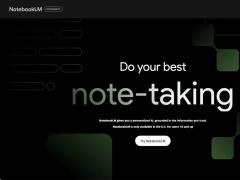Among the experimental tools that Google offers is NotebookLM, a bare-bones notes app that you use in your web browser. What makes it interesting is that it uses Google’s generative AI chatbot (variously known as Bard or Duet AI and now rebranded as Gemini) to analyze sources of text that you “feed” it, and then generate notes based on the information in them.
Here are some scenarios where you might want to use NotebookLM:
To turn the contents of a long document into a brief summary.
To extract insights from several documents that cover a certain topic. For example, you can have NotebookLM analyze documents that pertain to a project that your business is working on.
To bring together and summarize information that you find while doing online research, such as snippets of text from web pages.
This guide will take you through setting up and using NotebookLM. You’ll need to have a Google user account to sign up for Google Workspace Labs (if you’re not already a member) and to sign in to NotebookLM. You must be at least 18 years old and live in the US to use NotebookLM.
When using NotebookLM, keep in mind that generative AI tools are in their infancy and sometimes get facts wrong. Be sure to fact-check all responses in this or any other genAI tool. Also note that this is an early beta product, and its performance can sometimes be glitchy.
Create your first notebook
In NotebookLM, a “notebook” contains one or more notes. You can create several notebooks. So each notebook represents a project that you’re working on, containing notes that are specific to that project.
On the start page of your NotebookLM account, click New Notebook. On the small panel that opens, type a name for the new notebook.
Starting a new notebook in NotebookLM. (Click image to enlarge it.)
When you click Save or press the Enter key, NotebookLM will switch to a new page showing the workspace of your new notebook.
A new blank notebook. (Click image to enlarge it.)
Add your sources
The sources of text that you add for NotebookLM to analyze will appear as cards on the panel that runs down the left side of the workspace.
On the Sources panel, click ADD SOURCE or the + sign to the right of “Sources.” A small panel will open that presents three ways that you can add a text source:
Drive: You select a Google Docs document that’s stored in your Google Drive.
PDF: You upload a PDF that’s stored on your PC. (Note: you cannot add a PDF that’s stored in your Google Drive.)
Copied text: A blank source card opens over the workspace. You can paste text into it that you’ve copied to your PC clipboard, such as text from an email or messaging chat. You can also copy and paste in a web link for NotebookLM to analyze. And you can optionally type in additional text.
Designating a new source. (Click image to enlarge it.)
After you make your choice and go through the steps that the NotebookLM interface guides you through, your source will appear as a thumbnail on the source panel.
You can have up to 20 sources in a notebook, and each source must contain fewer than 200,000 words. NotebookLM doesn’t currently support images, media files, or complex tables or charts as sources.
Google says that the data you upload is not used to train NotebookLM and will stay private, but the company also warns, “Avoid uploading documents with any personal or sensitive information” and “Avoid uploading documents you don’t have the applicable rights to.”
Create and manage notes
A notebook can have up to 1,000 notes. To create a new note manually, click the Add note button that’s at the upper right of the Notes panel. A card for a new note will appear on the Notes panel.
A card will appear on the main workspace for each note you create. (Click image to enlarge it.)
Click this card and it’ll open as a panel over the workspace. You can type text into this panel, as well as paste text saved on your PC clipboard.
Adding text to a note. (Click image to enlarge it.)
When you’re finished, click the double-arrow icon at the lower right of the panel. Your note will once again appear as a card on the Notes panel. Click it to reopen it so you can read or edit it.
To delete a note, move the pointer over its card. Click the square that appears on its upper-right corner. This will add a blue checkmark inside the square. Then click the Delete notes button at the top of the Notes panel. To delete multiple notes at once, select their individual note cards (or click the Select all button) and click Delete notes.
Deleting notes from a notebook. (Click image to enlarge it.)
With those basics out of the way, we can get to the true power of NotebookLM: its built-in chat with genAI capabilities.
